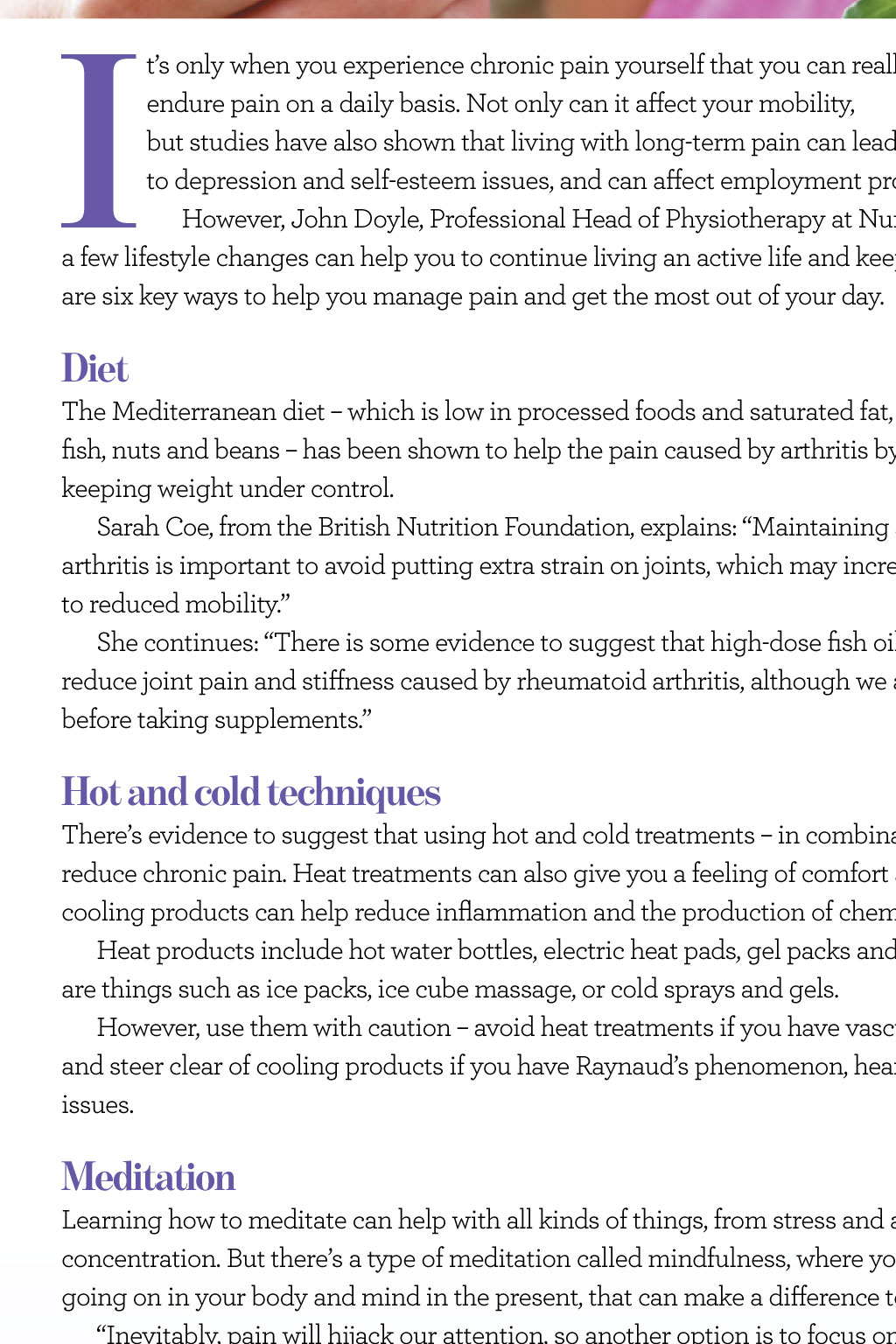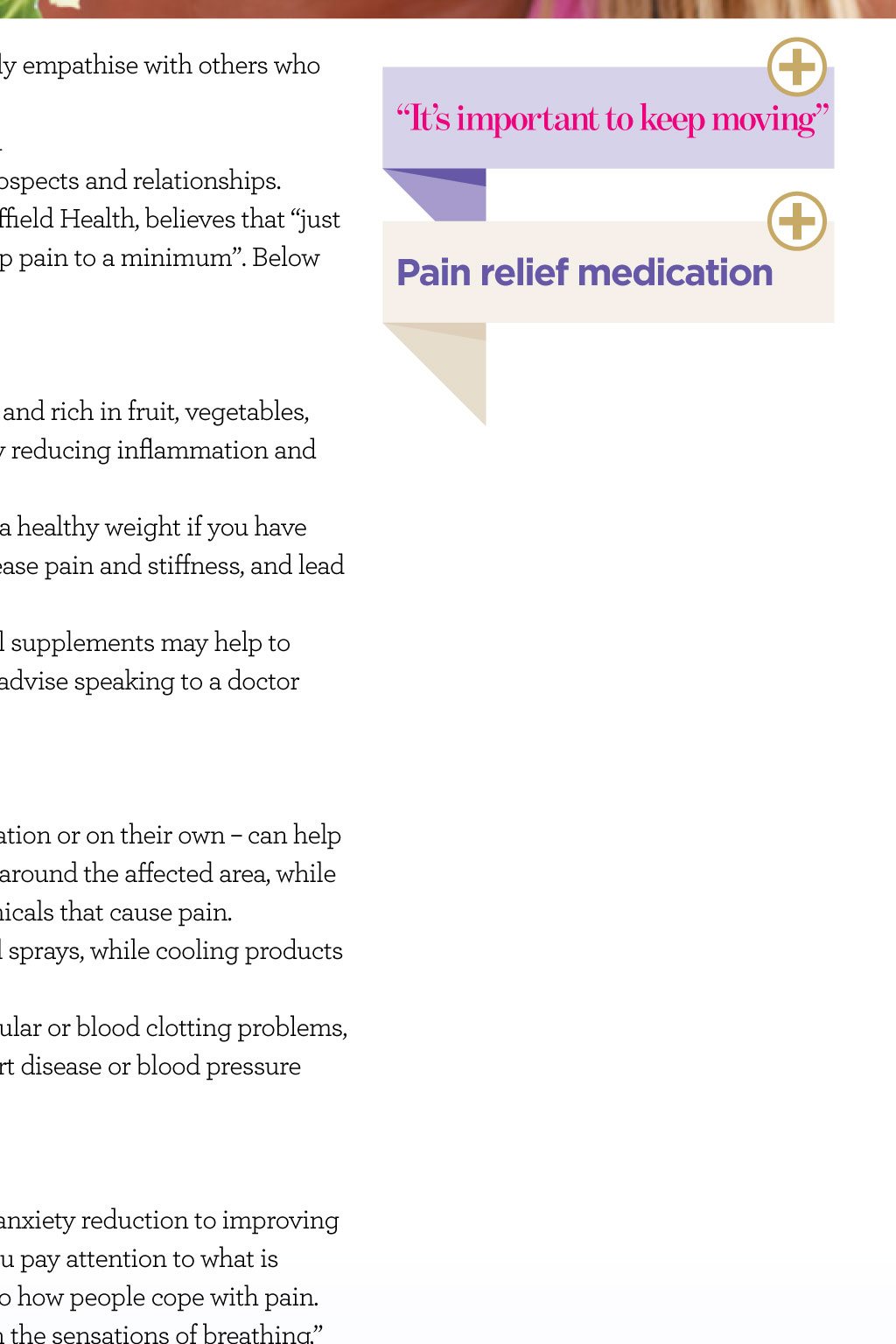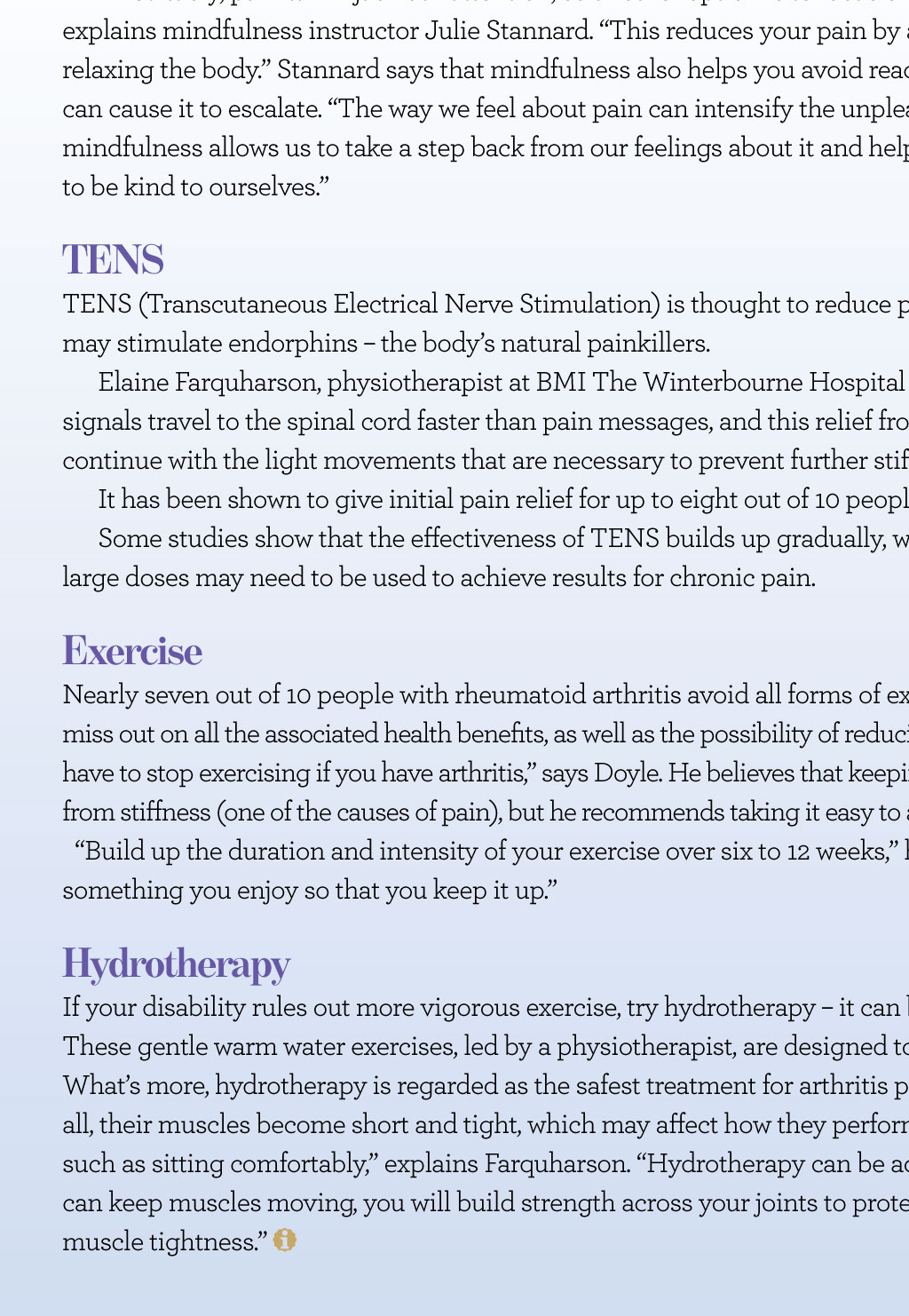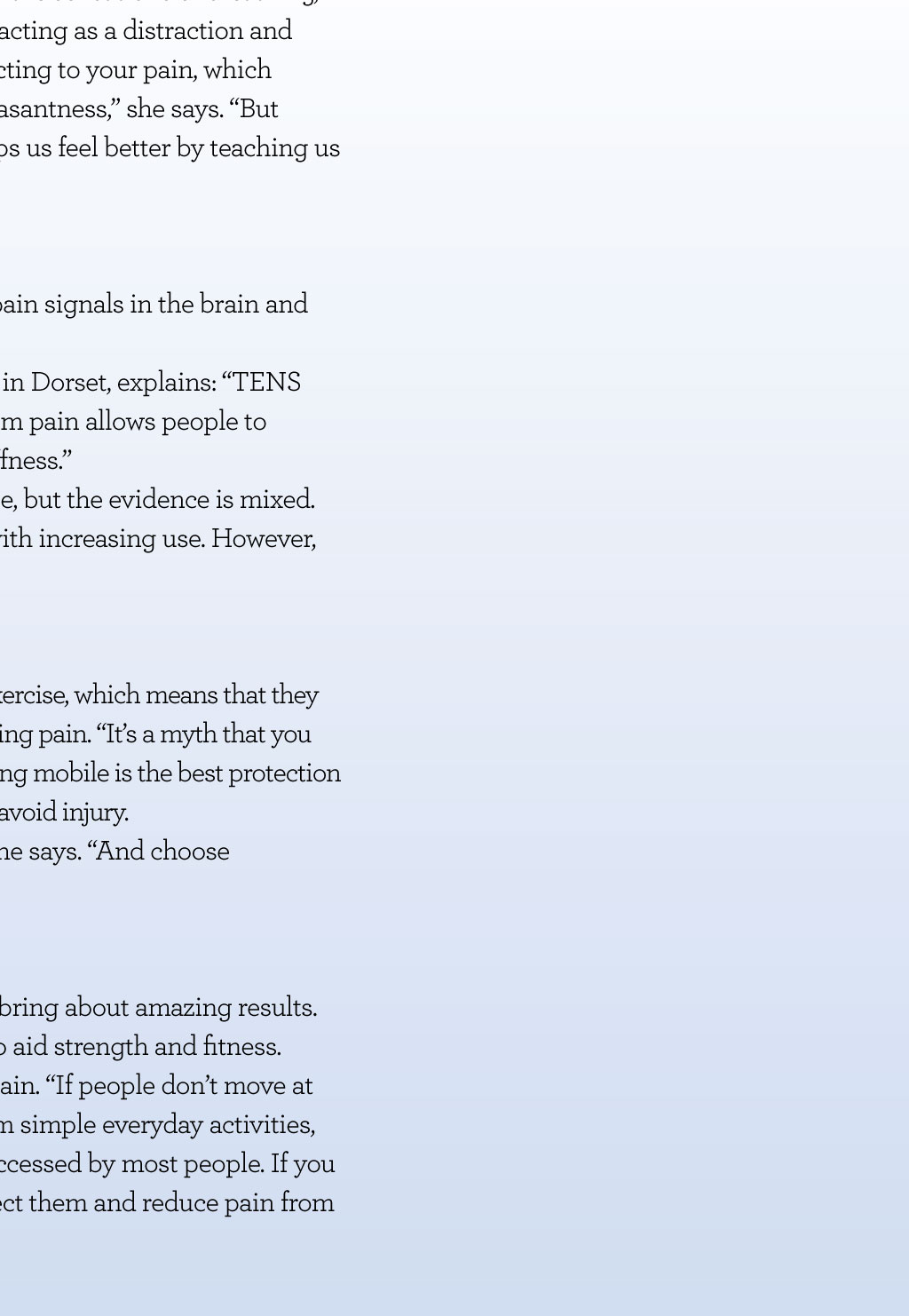














Health ways to help you manage pain Living with chronic pain can have a major impact on your life, but there are ways to help manage it. Read on to find out what could work for you WORDS: heather stephen I ts only when you experience chronic pain yourself that you can really empathise with others who endure pain on a daily basis. Not only can it affect your mobility, but studies have also shown that living with long-term pain can lead to depression and self-esteem issues, and can affect employment prospects and relationships. However, John Doyle, Professional Head of Physiotherapy at Nuffield Health, believes that just a few lifestyle changes can help you to continue living an active life and keep pain to a minimum. Below are six key ways to help you manage pain and get the most out of your day. Diet The Mediterranean diet which is low in processed foods and saturated fat, and rich in fruit, vegetables, fish, nuts and beans has been shown to help the pain caused by arthritis by reducing inflammation and keeping weight under control. Sarah Coe, from the British Nutrition Foundation, explains: Maintaining a healthy weight if you have arthritis is important to avoid putting extra strain on joints, which may increase pain and stiffness, and lead to reduced mobility. She continues: There is some evidence to suggest that high-dose fish oil supplements may help to reduce joint pain and stiffness caused by rheumatoid arthritis, although we advise speaking to a doctor before taking supplements. Hot and cold techniques Theres evidence to suggest that using hot and cold treatments in combination or on their own can help reduce chronic pain. Heat treatments can also give you a feeling of comfort around the affected area, while cooling products can help reduce inflammation and the production of chemicals that cause pain. Heat products include hot water bottles, electric heat pads, gel packs and sprays, while cooling products are things such as ice packs, ice cube massage, or cold sprays and gels. However, use them with caution avoid heat treatments if you have vascular or blood clotting problems, and steer clear of cooling products if you have Raynauds phenomenon, heart disease or blood pressure issues. Meditation Learning how to meditate can help with all kinds of things, from stress and anxiety reduction to improving concentration. But theres a type of meditation called mindfulness, where you pay attention to what is going on in your body and mind in the present, that can make a difference to how people cope with pain. Inevitably, pain will hijack our attention, so another option is to focus on the sensations of breathing, explains mindfulness instructor Julie Stannard. This reduces your pain by acting as a distraction and relaxing the body. Stannard says thatmindfulness also helps you avoid reacting to your pain, which can cause it to escalate. The way we feel about pain can intensify the unpleasantness, she says. But mindfulness allows us to take a step back from our feelings about it and helps us feel better by teaching us to be kind to ourselves. TENS TENS (Transcutaneous Electrical Nerve Stimulation) is thought to reduce pain signals in the brain and may stimulate endorphins the bodys natural painkillers. Elaine Farquharson, physiotherapist at BMI The Winterbourne Hospital in Dorset, explains: TENS signals travel to the spinal cord faster than pain messages, and this relief from pain allows people to continue with the light movements that are necessary to prevent further stiffness. It has been shown to give initial pain relief for up to eight out of 10 people, but the evidence is mixed. Some studies show that the effectiveness of TENS builds up gradually, with increasing use. However, large doses may need to be used to achieve results for chronic pain. Exercise Nearly seven out of 10 people with rheumatoid arthritis avoid all forms of exercise, which means that they miss out on all the associated health benefits, as well as the possibility of reducing pain. Its a myth that you have to stop exercising if you have arthritis, says Doyle. He believes that keeping mobile is the best protection from stiffness (one of the causes of pain), but he recommends taking it easy to avoid injury. Build up the duration and intensity of your exercise over six to 12 weeks, he says. And choose something you enjoy so that you keep it up. Hydrotherapy If your disability rules out more vigorous exercise, try hydrotherapy it can bring about amazing results. These gentle warm water exercises, led by a physiotherapist, are designed to aid strength and fitness. Whats more, hydrotherapy is regarded as the safest treatment for arthritis pain. If people dont move at all, their musclesbecome short and tight,which mayaffect how they perform simple everyday activities, such as sitting comfortably, explains Farquharson. Hydrotherapy can be accessed by most people. If you can keep muscles moving, you will build strengthacrossyour jointsto protectthemand reduce pain from muscle tightness. Its important to keep moving whats a slipped disc? whats a slipped disc? pain relief medication its important to keep moving Elaine Searle has osteoarthritis in her hips I find the best way to manage my arthritis is through regular exercise and diet. If I didnt keep moving, Id seize up. It does hurt sometimes, so I find its best to take things gently. I teach three chair-based exercise classes a week to around 50 people with arthritis and other limiting health conditions. Some of my ladies are in their 90s they have all sorts of conditions, including arthritis. I think its great to do exercise in a group, as its just as much a social activity as health activity it helps you to forget the pain. And its always good to exercise your chuckle muscles! I get as much out of it as they do. Its important to keep moving even if it is only your fingers and toes. Try gentle activities like playing the piano or knitting. pain relief medication While some lifestyle changes can help your pain levels, pain medication is also important to help you deal with your condition. Your GP or specialist can advise on the best treatment for you paraCetaMol is effective in treating mild to moderate pain and is the first treatment recommended for osteoarthritis. But it doesnt reduce inflammation, so if you have rheumatoid arthritis you will normally be advised to take paracetamol in combination with a drug such as ibuprofen. CoMpounD analGesiCs where two drugs are combined, such as paracetamol and codeine, are the recommended treatment for moderate pain caused by osteoarthritis. opioiD analGesiCs like codeine, morphine or tramadol, are only available on prescription and are generally tried when other options have failed. They come in a tablet or patch, and have to be monitored by a doctor as they can be addictive.